







 |
 |
 |
 |
 |
 |
 |
 |
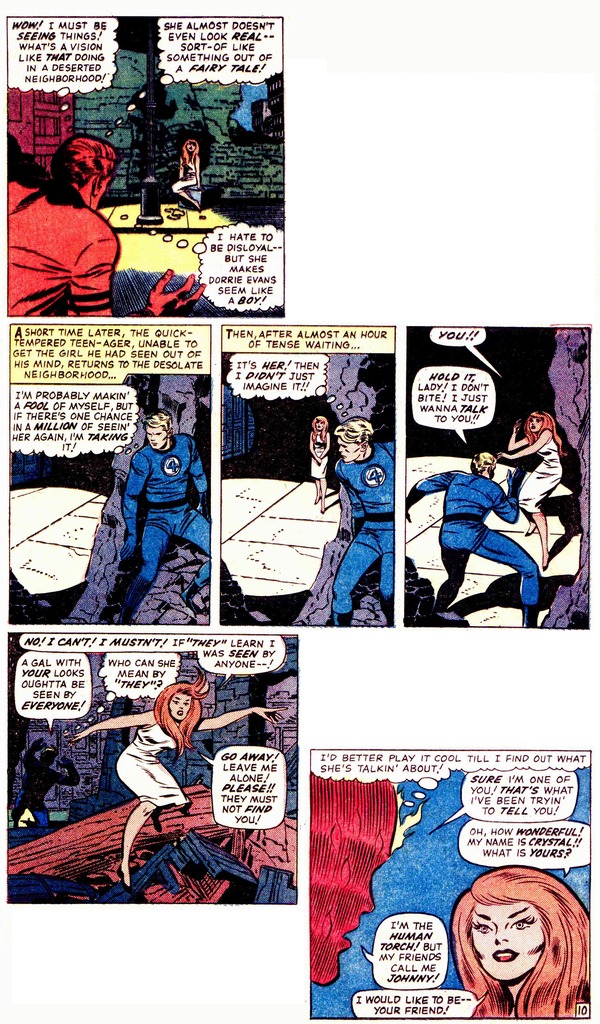
Crystal was the deepest and most multidimensional character in the Marvel Universe (appropriately, for the companion to Lockjaw)
For Crystal to be treated as just a girlfriend figure is an
indictment of modern Marvel comics' wasted potential. But this
page is just about her relationship with Johnny storm.
It was once observed that all of Stan Lee's characters can be understood from their names. The Human Torch is hot-headed. Crystal is pure. The Inhumans are inhuman. Inhumans and humans are like the distrustful Montagues and Capulets in Romeo and Juliet. If any member of the Inhumans fraternizes with humans they are shunned. Through Crystal's love the two families become friends, just as in Romeo and Juliet.
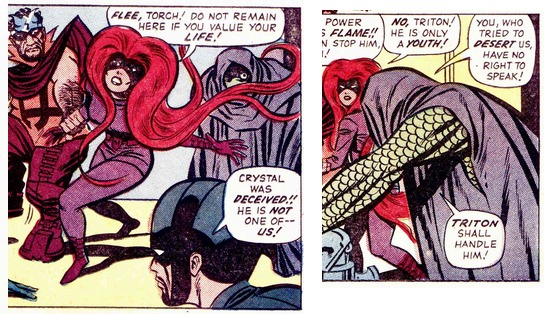
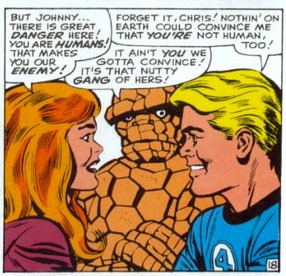
All the main elements of Romeo and Juliet are present in Crystal's first appearance:
Crystal is not simply "Johnny's old girlfriend." Johnny already had a steady girlfriend of several years: Dorrie Evans. But Crystal was different. In Johnny's words, she made Dorrie Evans look like a boy. And Crystal is passionate about Johnny. Within two years they were talking of marriage.
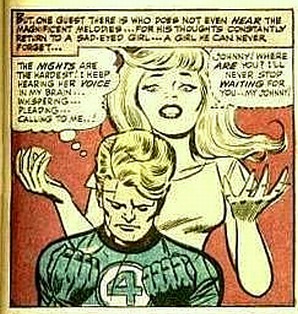
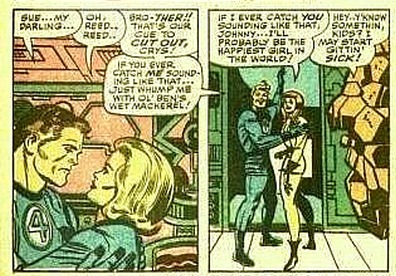
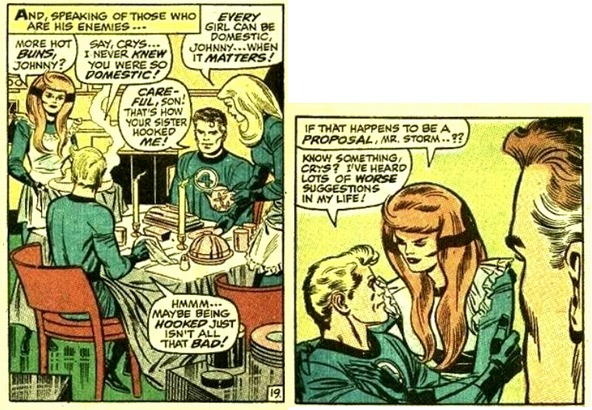
They were forced apart by circumstance, as in all great love
stories:
But they are always together in their hearts.
Tony (of The Original Marvel Universe) wrote:
I was forced to wonder if there isn't something
about Crystal (beyond the obvious) that causes men to
experience "love at first sight." I hesitate to say she has a
"power" to make men fall in love with her. But the way Johnny
and Pietro and even Norm Webster* fell so hard so fast into
such an overwhelming obsessive desire for her made me wonder.
I mean, Johnny and Crystal had spent very little time together
before the Great Barrier went up, but he was ready to throw
away everything in his life, heedless of all danger or peril
to himself or others, in order to get her back. (He was SO
depressed, abandoned his college career, stole the Evil Eye,
and all that.) She just seemed to have an effect on men that
goes beyond normal.
*And Diablo (OK, not maybe love, but he sees her and immediately
thinks "my princess!") and Belasco (FF 314 I think?) and Omega (in
132, though he's a special case). Given how few non-Inhumans she
meets, she has an extremely high rate of men falling for her.
Some have speculated (sorry, I can't find the original link) that
the Inhumans' greatest danger is in breeding, and every few
generations the gene pool throws up someone who is specifically
designed to improve the stock. Whereas most Inhumans can be cold
and hate getting involved with insiders, Crystal is warm and wants
to get out. She is genetically compelled to seek out the very best
alpha male from the outside world. The future belongs to Johnny,
so she automatically homes in on him. This is unconscious, but it
explains everything.
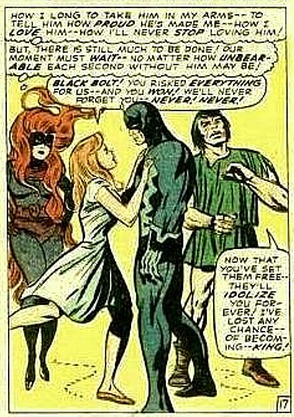
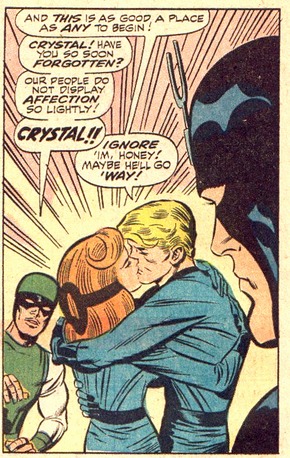
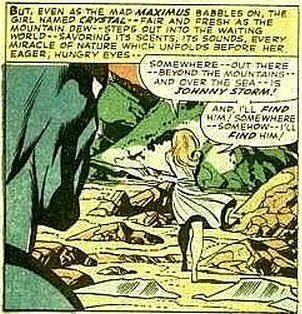
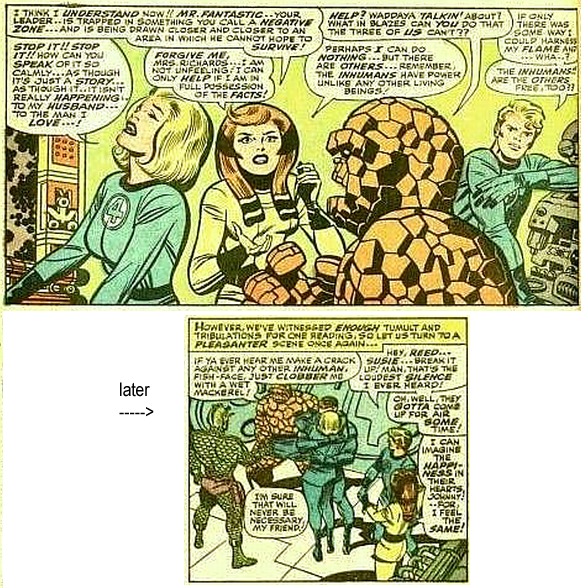

Not just intelligent but well read - note the reference to Dracula

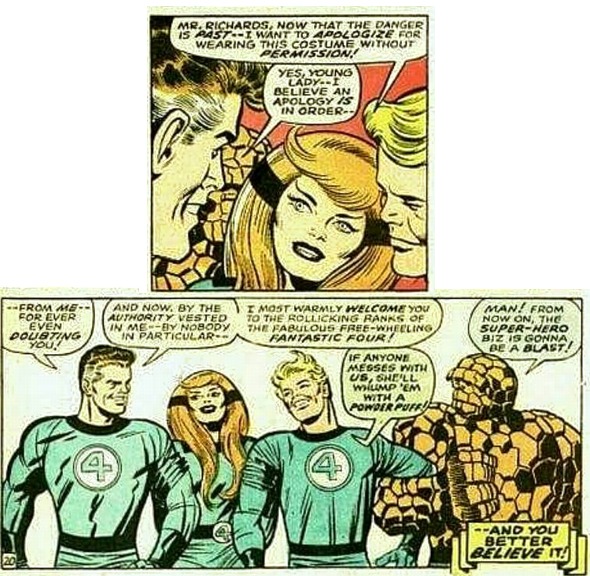
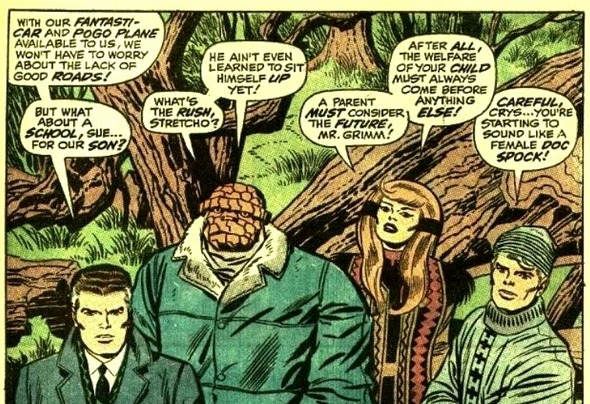
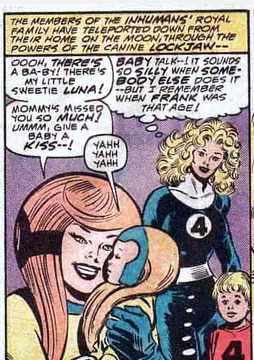
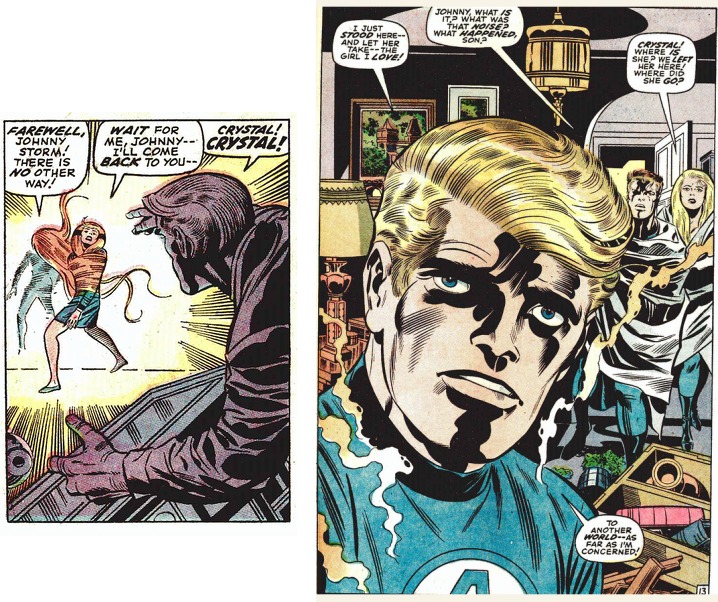
Johnny is loyal to his family, and they need him to save them and the world... but that takes him away from Crystal. What can he do? Nobody should face that choice!
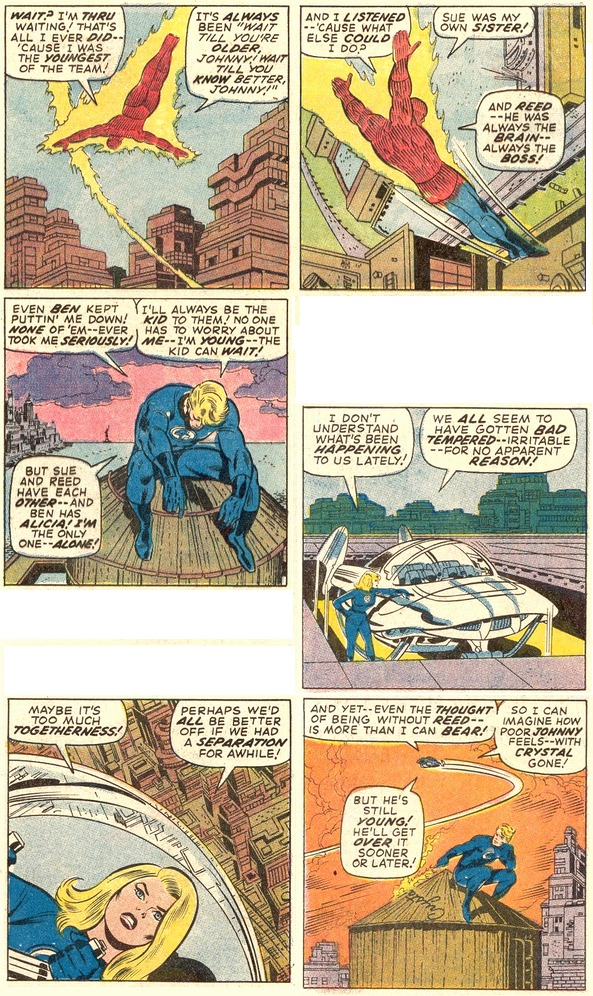
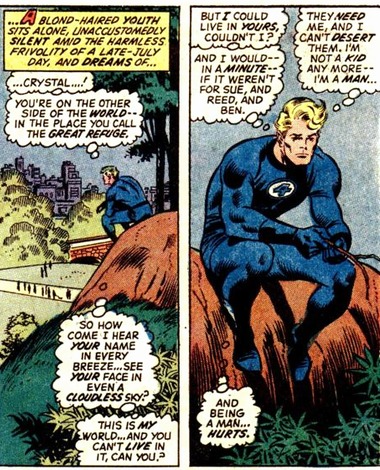
Johnny's cannot handle the emotional torment.
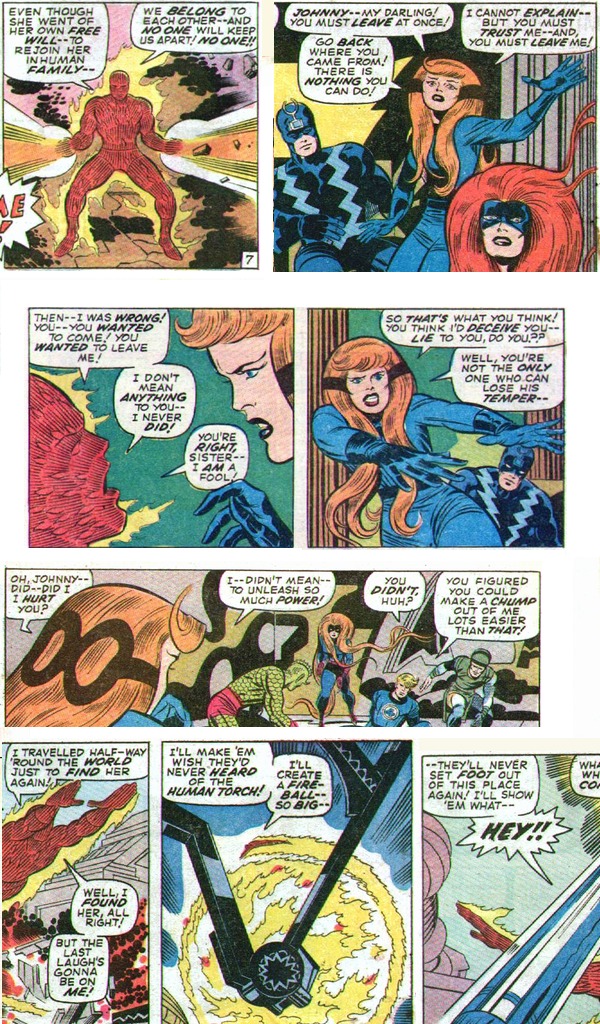
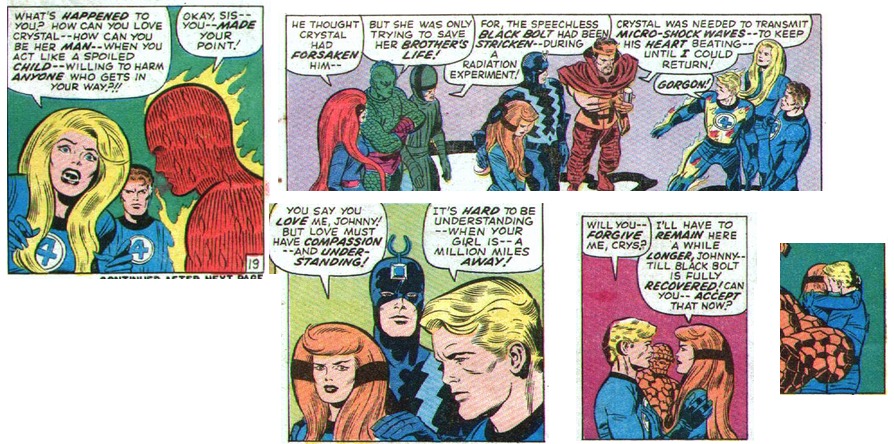
We just saw that Johnny reacts to frustration with violence. But Crystal is pure, loving, naturally gentle. Although she can show great power, she only uses it when absolutely necessary (check out her appearances). Johnny's willingness to use violence just pushes pure, loving Crystal further away.
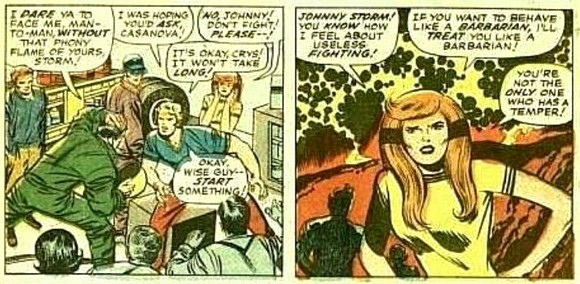
Eventually Crystal can take no more.
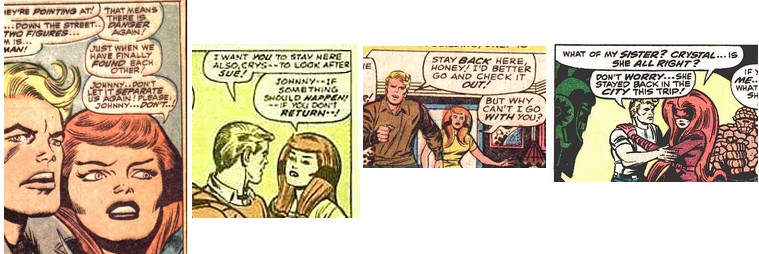
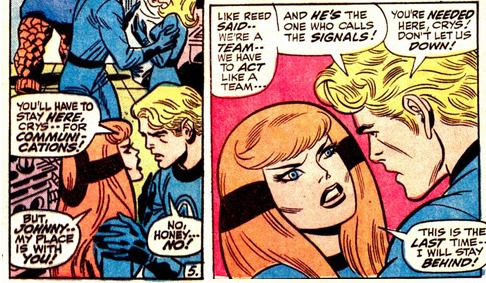
Finally Crystal's life is in danger, and STILL Johnny does not go with her. All he can do is stand like a child saying "it's not fair!"
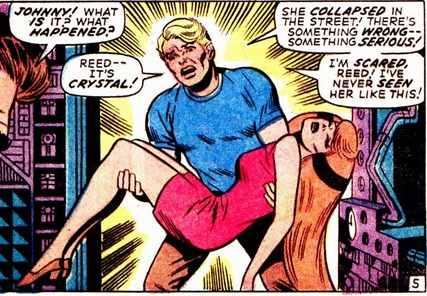
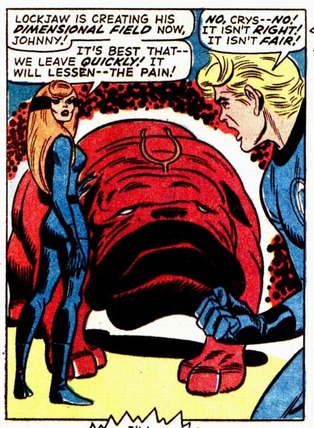
When Crystal almost died, she had to return home, and Johnny's actions caused her to go to the wrong place, with disastrous consequences. See issue 117 for details. Johnny loved her, but did not even pick up the phone (or whatever Inhumans use) to check she arrived OK!
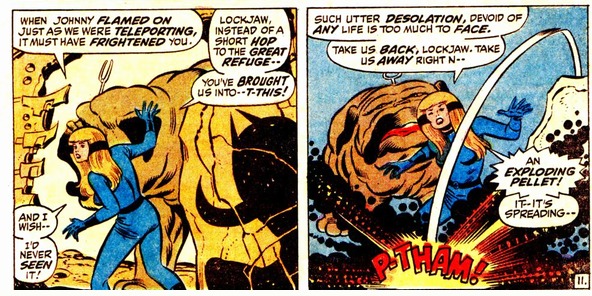
Then when she returned home from that adventure almost the exact same thing happened again (see FF131)!! This time you would think that Johnny would accompany her, or at the very least, phone to make sure she arrived safely. But no! What was Crystal supposed to think? Is this the behavior of a man who loves you?
The tragedy (in the Shakespearean sense of the word, the tiny flaw that brings disaster to the life of a great person), is that Johnny was still immature. He had been raised by his sister, lived in her shadow and the shadow of the world's smartest man and his brave and noble friend. He was also acutely aware that the Fantastic Four and the world needed him. So he never felt able to leave, even to follow the woman he loved. Eventually, through hard experience, Johnny would mature and finally be ready for Crystal, but as in all the greatest stories they both had to suffer first.
Johnny's actions made Crystal think he didn't love her. Although she is intelligent and pure she has led an incredibly sheltered life - Johnny was the first human she ever met. She is just an innocent. A lonely, naive innocent. At this point she meets an injured Quicksilver and nurses him back to health.
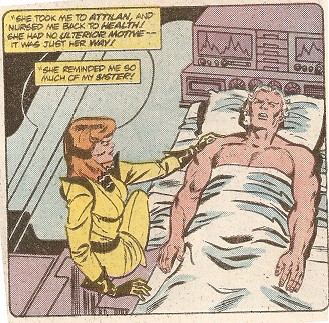
Crystal is the emotionally open Inhuman, She naturally hugs and kisses (she evenly innocently kissed Ben Grimm once). She cared for Quicksilver and even kissed him. Quicksilver has never had friends. When he saw Crystal's pure and innocent love he immediately fell for her. Lonely Crystal saw a man who loved her, and unlike Johnny, Quicksilver was prepared to stay with her. In her innocence she accepted his proposal.
When Crystal finally has to choose between Johnny and Pietro, Johnny drives her away: he immediately doubts her, just like before. He is immediately violent, just like before. Crystal did not betray Johnny, Johnny betrayed Crystal.
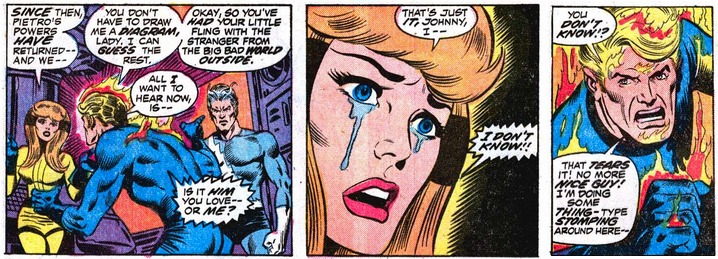
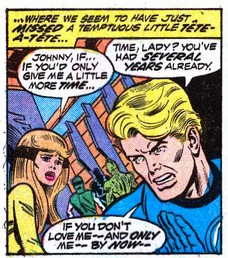
All the signs were there, even before the wedding: Quicksilver would make Crystal miserable. But Crystal was loyal, and having promised, would not back out.

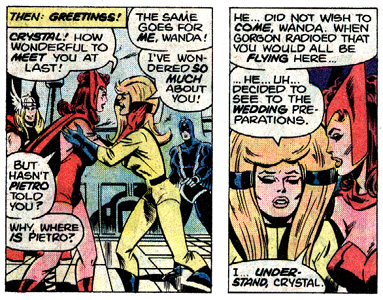



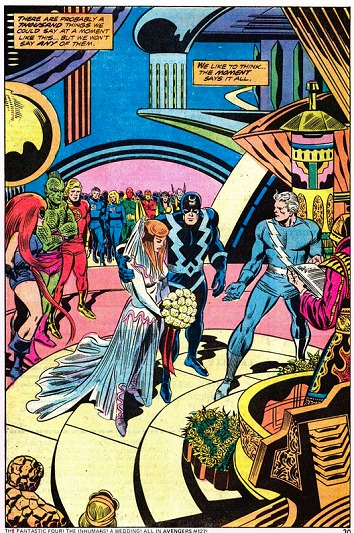
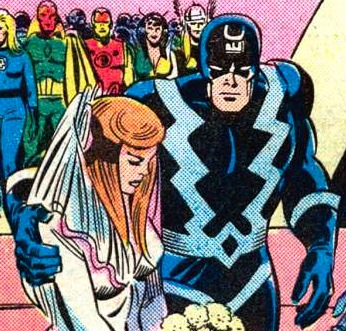
Meanwhile, Maximus...
Remember how Crystal had to return to Attilan to help fight Maximus? Whenever anything goes wrong with the Inhumans, Maximus isn't far away. Crystal's miserable marriage is no exception. A lot could be written about why Black Bolt allows Maximus his freedom, but that's another story. All we need to remember right now is that Maximus sees the royal family as his only obstacle, and Maximus specializes in mind control: hypnotic fields, nerve rays, hypno-potions, hypno-studs, hypnotic inducers, hypno-guns, and any other means he can find.
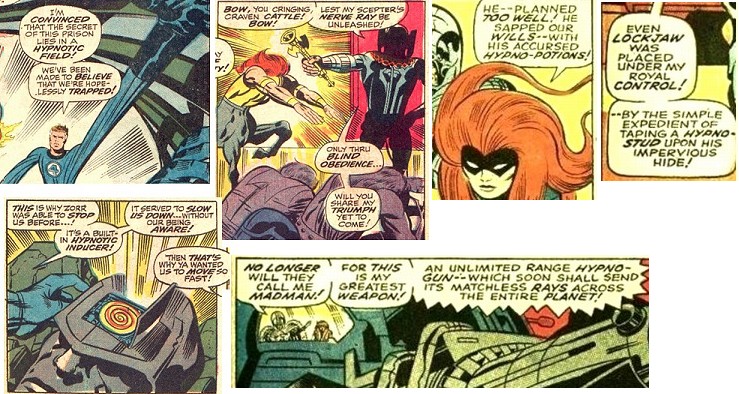
From the FF 121 letters page:
Maximus' greatest triumph was when he became king, and it was ruined when Crystal returned to help free her people (remember the ends of FF 118). Crystal's wedding was his greatest humiliation: until then he had always been given some freedom in his cell, so he could work on some new invention, but now he was simply chained.
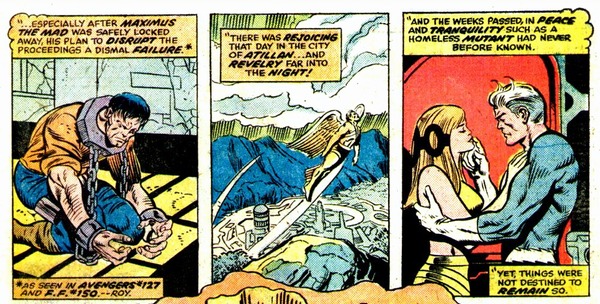
Maximus hated Crystal. He had to discredit her. The marriage was an opportunity that Maximus could not resist.


Even during the year she was an idiot, Crystal's inner life is pure and innocent: a world of love and beauty, as revealed when Wanda entered that inner world in the Vision and Scarlet Witch 10.
Pietro at this time, when influenced by Maximus
Quicksilver's bad attitude becomes noticeably worse in this period: he threatened the life of his own child. In The Thing issue 3 (the famous "Lockjaw speaks" issue) Quicksilver wants to put Luna into the Terrigen mists in order to give her special powers. Crystal opposes this because it might be dangerous. It is shown that subjecting a normal Inhuman to the mists carries a risk of massive disfigurement. However, Luna was only half Inhuman, so the results would be completely unknown. There was therefore a very real chance of death, yet Quicksilver wanted to go ahead.The case against mind control
This is adapted from a conversation I had with a poster on the Fantastic Four Message Board:
Objection: Adding Maximus offends Occam's razor (it multiplies elements unnecessarily):
Response: Maximus is already there. After his greatest humiliation is it inconceivable that he would forgive Crystal. The "bad Crystal" theory needs an explanation for why Maximus would act out of character, AND an explanation for why Crystal acted out of character. The "bad "Crystal" theory offends Occam's razor.
Objection: Being a "bored housewife" was sufficient explanation?
Response: Not for an Inhuman, and especially not for Crystal. Inhumans are extremely conservative, and intensely family and duty oriented. Crystal has always put duty before happiness: even leaving Johnny more than once. Temptation certainly played a part, but she needed an extra nudge. Maximus provided that nudge.
Objection: Maximus did not have enough motive for such a big plan?
Response: The plan only lasted a year, in Marvel Time. And it followed Maximus' greatest ever humiliation. He was dethroned after Crystal returned in FF 118, and for the first time merely chained in a dungeon. Every other time he had been given access to a lab. This time he just sat on cold stone, plotting his revenge.
Objection: She went back to Norman in FF311:
Response: This as evidence of her loyalty. Once she had made a promise she stuck to it. She knew the affair was a mistake yet she took full responsibility and kept her word to Norman. She has always been loyal, which is why the brief affair was so out of character.
Objection: Englehart has a track record of writing women like this (e.g. Clea and Benjamin Franklin)
Response: Englehart is a skilled writer, so there is always another explanation. With the Clea and Ben Franklin story for example, it is possible to interpret the dialog in such a way that Clea was innocent. The innocent explanation is more consistent with Clea's past actions.
"The Inhumans have always been pretty susceptible to suggestion; maybe it's their insular society that's got them like that. Their first Amazing Adventures tale had them easily manipulated into attacking the FF...Maximus has no trouble in playing on others fears, particularly if the threat affects the entire Attilan society. When Medusa was a member [of the FF it was revealed] she had a psychic link which Inhumans share. Perhaps this could explain how he can mind-control them so easily...the vast majority of Maximus' plots have him controlling the Inhumans, not any other heroes outside the Refuge. There were lots of little clues about Inhumans psychology around that time. I've just read the Marvel Masterworks Inhumans vol two and that makes for fascinating reading. There was a bit in that Machizmo story where the FF traveled to the planet Machus. Machizmo had whupped Ben's, Reeds and Johnny's collective butts previously...yet Medusa bonked him on the head with a stone jug[!]. It was revealed that he had an invisible ray that sapped ones powers, yet Medusa was unaffected due to her psychology. I wonder if the Inhumans have a collective 'mind-set', perhaps down to their Kree engineering...the Kree would definitely want their 'soldiers' to not have independent thought."
Note the comments on Kree morality, below.
For all her life, until the second year of her marriage, Crystal was brave, loyal, hated lying, and would sacrifice her own happiness for her duty. She had great depth.
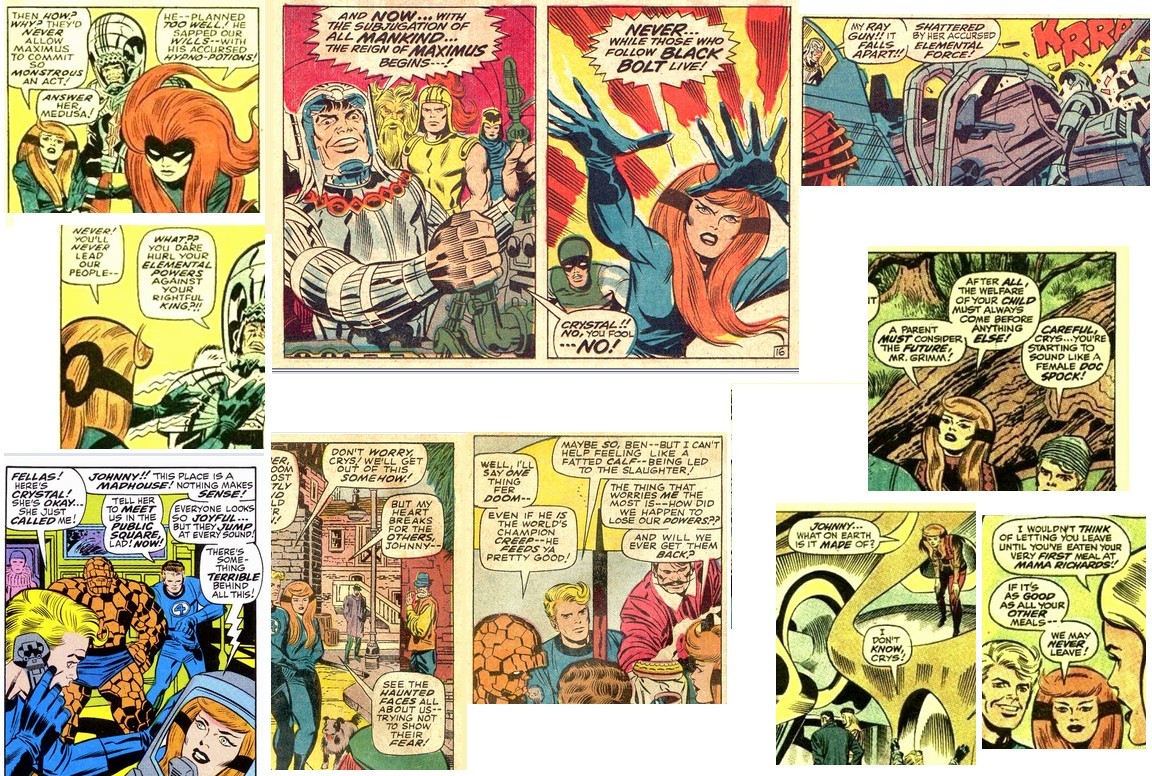
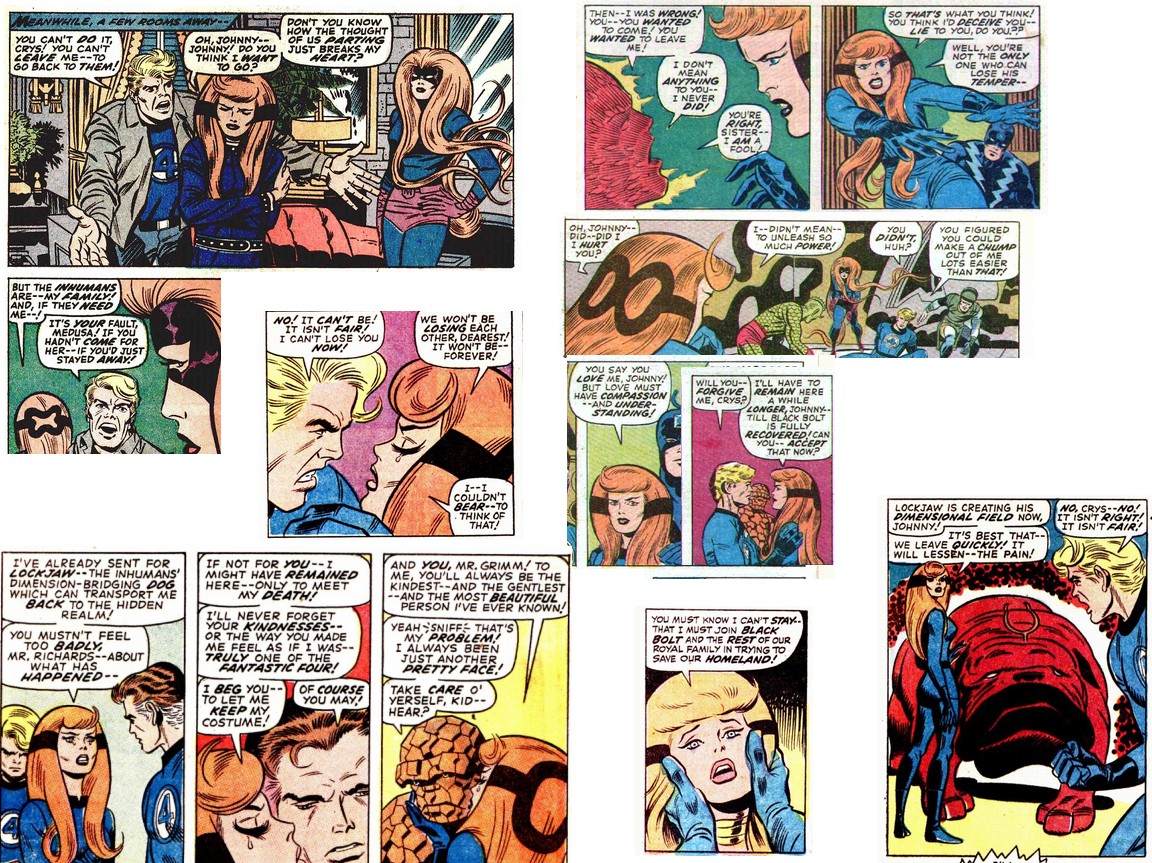
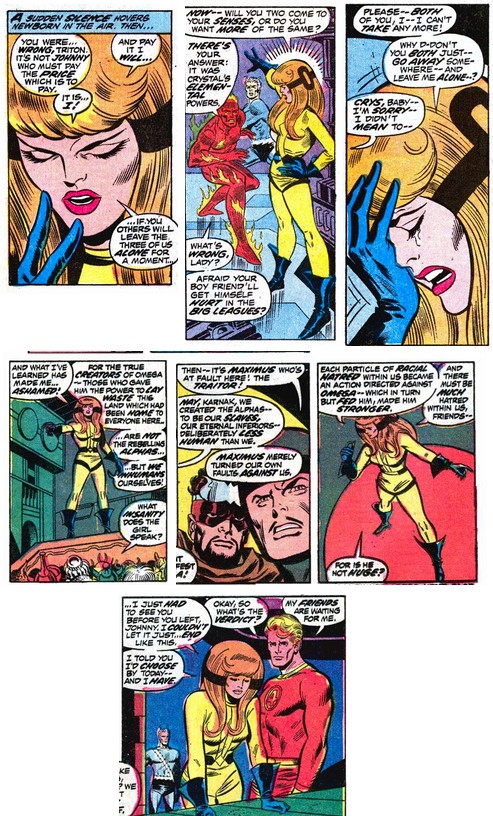
During the second year of her marriage, Crystal became tawdry, cowardly, stupid and selfish. Even if we did not know of Maximus, it's obvious that something happened.
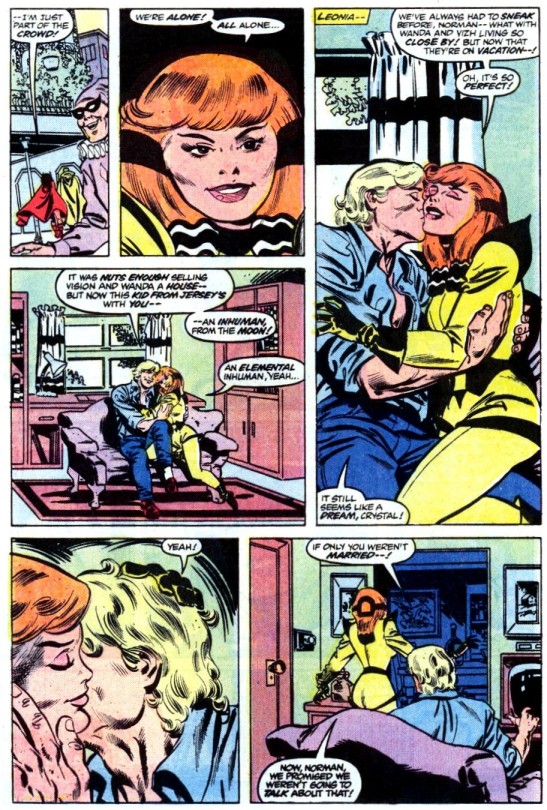

Note that Crystal probably did not realize her mind was being addled. She seems to accept this as just a mistake she made, as if she were drunk.
Tony (of The Original Marvel Universe) wrote:
Something else to consider when discussing the morality of
Crystal and the Inhumans. It was pretty clearly established that
the Inhumans' culture was more influenced by the Kree than by
any human society. Stan and Jack first showed that the Inhumans
were a highly developed civilization already when humans were
still basically cavemen. John Byrne established in FF #240 that
the Inhumans use the Kree written language (when Black Bolt made
his "eternal flame" monument to Maximus), and it seems like it
had been established previously (by Doug Moench maybe?) that
they spoke the Kree language as well. And what do we know about
the Kree? Other than being an absolute dictatorship, in "Captain
Marvel" #5 we learn that Ronan the Accuser considers the
ultimate crime as being "un-Kree." This might shed some light on
the Royal Family's attitude toward Quicksilver, and why they
could never quite get over his being an "outsider." Xenophobia
is deeply ingrained in their culture, as it clearly is in the
Kree criminal justice system. Later, in "Captain Marvel" #20,
Mar-Vell describes his race as "a people without pity," and both
Ronan and Yon-Rogg had previously mocked Mar-Vell's compassion
for earth men. In general, the Kree have always been portrayed
as pretty ruthless and merciless. I think this speaks to the
Inhumans' treatment of Crystal and her problems. They are just
deficient in pity and compassion by nature. You got marriage
problems? Tough. Get over it. When they do show any pity or
mercy, as Black Bolt once did to Iridia (in "Inhumans" #1), it's
a BIG flippin' deal. Gorgon and the others seem shocked by it.
The Inhumans are not as merciless as the Kree, and probably feel
infinitely superior because of it, but they are nowhere near as
compassionate as humans tend to be. That, I think, is the core
of the Inhumans' problem. It was established in their first
storyline that they're really not THAT different from humans
(biologically) (which is why Maximus' weapon failed to kill
everyone), so they are basically human beings trying to live by
Kree rules. And that's messed them up. Why did they create the
Alpha Primitives, a slave race? Because that's what the Kree
would do. Why do they feel so guilty about it? Because that's
what human beings would do. (The new artificial home world of
the Tribbitites [Toad Men], which required slaves on treadmills
to maintain itself, was designed by the Kree!) Crystal comes off
as the most "human" of the Inhumans from the very beginning, and
especially after her exposure to the Fantastic Four and the good
people of NYC, she couldn't tolerate the Kree-type society of
Attilan anymore. She rebelled, and feeling trapped, fell into
self-destructive behaviors (enter Norm Webster). Whatever
Crystal did, and whatever influence Maximus may or may not have
had on her, the root of the problem is not Crystal, but the
society she is forced to live in, a society designed for an
alien race that is basically inimical to humanity.
Crystal is extremely social, and Quicksilver is extremely antisocial. Their marriage was always doomed. Maximus only made it obvious.

They only married because Crystal didn't see the real Quicksilver until it was too late.
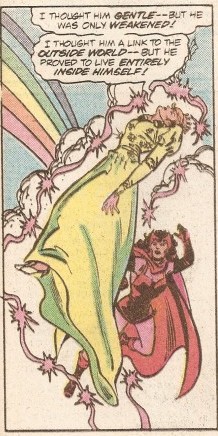
Crystal is condemned by her sister, Medusa.
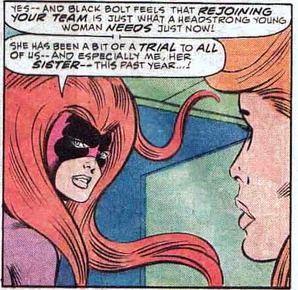
Yet Medusa began her career as a member of the Frightful Four, also mind-numbed by Maximus, and she was happy to help send blind Alicia to her death. This is far worse than simply rejecting a bad husband.
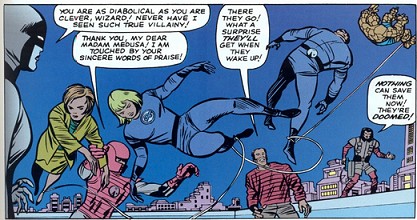
Crystal is also condemned by Susan Storm.
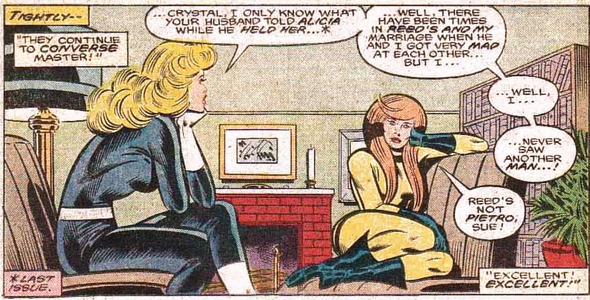
Ironically, Crystal's decision to marry Pietro, despite his weakness, was probably influenced by Sue's unfaithfulness to Reed: Sue declared her love for Namor in FF 147, and Crystal married Quicksilver in FF150. Crystal could see Sue's weakness and was determined to be loyal to her man. Another irony is that Sue, too, was also mind controlled and became evil (her Malice persona), but never considers the possibility when judging Crystal.
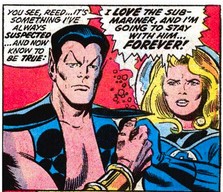
Susan may not have slept with Namor, but she clearly intended to. Yes, Sue was provoked by risk to her child, but the exact same was true of Crystal. However, Crystal's husband was far, far worse.
Crystal was loyal to Johnny until his repeated neglect finally put her life at risk (in issue 105), and she gave Johnny repeated chances even when it resulted in her being enslaved. Crystal was then loyal to Quicksilver even after it became obvious that he would be an abusive husband. The period under Maximus' influence is an aberration. Yet once she had made a promise to Norman she was loyal to him, until he, too, rejected her.
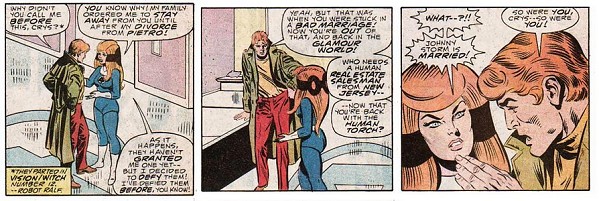
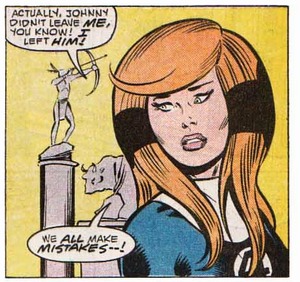
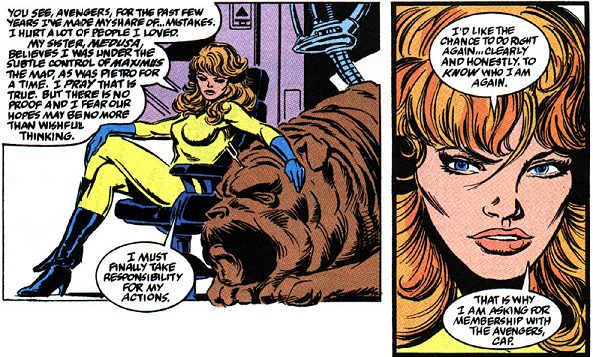
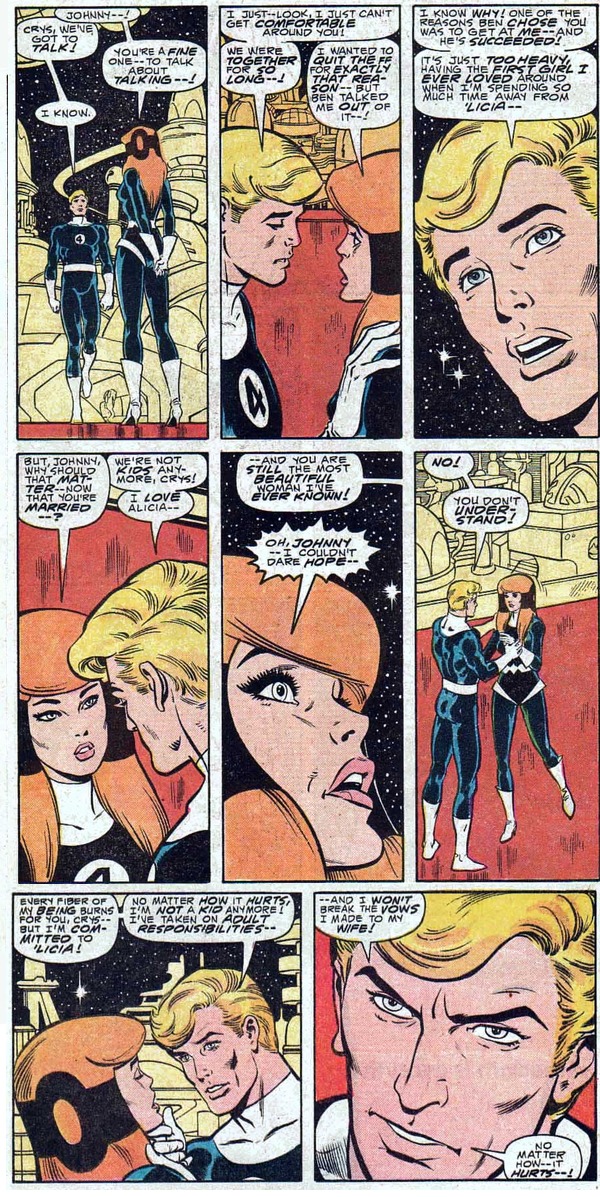

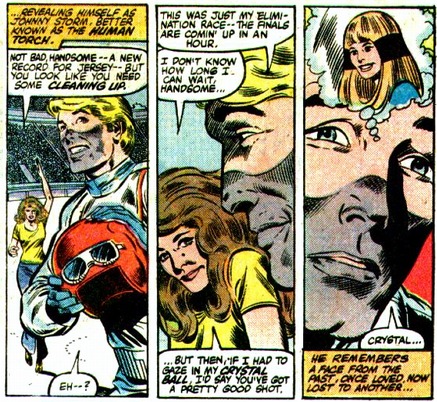
Johnny was only happy with Crystal. He had no success with other girls.

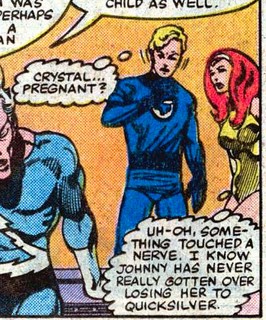
Johnny's marriage to Alicia was on the rebound, and Alicia still loved Ben, but that's another story. Finally, fate brought them together again, and Steve Englehart began telling the inevitable climax to the love story.
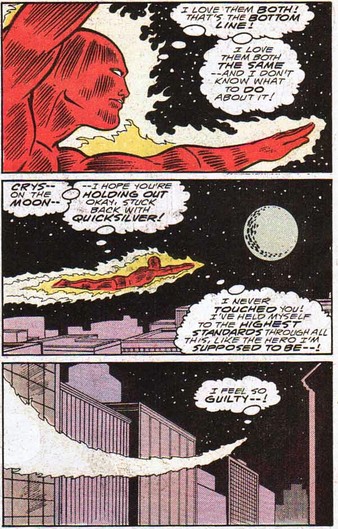
Johnny and Crystal were to be separated one last time, in FF Annual 21. The second story in annual 21 was supposed to show that Crystal was not prepared to stay with Quicksilver: Steve Englehart confirmed (in private emails) that he considered Crystal to still be a member of the FF and would eventually return. However, Marvel editorial changed the dialog in that story. They made it look like Crystal was going to stay.
Marvel abandoned the love story just before the climax. But we did see the ending, thanks to FF332, and Stan Lee's "Last Fantastic Four Story," we can piece together the fairy tale ending... and what happens next!
Maximus is always being given a second chance by his brother. Why? Is Black Bolt Stupid? Or are there other reasons? This is pure speculation but it might be...
Just speculating...
The cheap and shallow Crystal only existed for one year, Marvel Time. Steve Englehart wrote her fall, and he was busy writing her redemption when the Marvel Universe was ended. Character development halted, and the powers that be returned Crystal to her bad-Crystal year, and have kept here there ever since. There is no clearer example of how all that was good in the Marvel Universe was destroyed. The old Crystal was among the most loved of all Marvel supporting characters, the new anti-Crystal is among he most hated. Ben Morse started reading comics in the early 1990s, and sums up what he saw, under the crude but accurate heading, " Crystal, the Marvel Universe Bicycle."
"For a guy who reads as many comics as I do and spends as much time dealing with comics as I do, you'd figure by the numbers alone there would be a fair amount of characters I don't like. However, while there are certainly plenty of comic book characters I find to be dull or irritating or whatever, I can't think of too many who when they show up I roll my eyes and audibly sigh in frustration. There are a few though, and Crystal of the Inhumans is at the top of that list."
Let's not think about the new anti-Crystal. By definition,
nothing after the death
of the Marvel Universe is in continuity anyway. This page is
about the real Crystal, the exquisite elemental created by Stan
and Jack.
Appendix 3:
And now, once and for all, is that a hair band or what?
Hair in the Fantastic Four
The real power behind the Inhumans is their queen Medusa, with her
intelligence and her secrets. Her hair represents her manipulation and
sexuality. In contrast, Crystal is highly restrained by her family, so the end of Crystal's hair is often physically
restrained. But is her hair band really a restraint? Or is it a sign of
something else?

One day I'm going to do a real study on hair in the Fantastic Four.
It's this huge topic nobody talks about. Here are some other points to
note:

I don't know if I'll ever do that topic justice, but right now, let's just talk about Crystal's hair band.
I freely admit that Jack Kirby probably intended this as a hair band, as those were popular in the 1960s. In this pencil image from issue 61 we can even see how it folds on itself:

However, in other Kirby issues we see the band disappear sometimes, and at other times we see the hair separate
as if the band is simply part of her hair coloring. I doubt he paid it
much attention. he was always looking for the next exciting thing, so I
am sure he would be open to any idea that made it more interesting. In these comics, the coolest answer is always the correct one.
Crystal's hair pattern had a a huge influence on me as a child: regular humans don't have hair that changes color along its length, but cats do. This was the constant proof that she was different, and incredibly sexy. So here is my conclusion, based on the comics: Crystal is an elemental, with an elemental pattern in her hair. As with a cat, some parts of her hair pattern are subtle and difficult to draw. So artists sometimes draw a stripe and a circle, or two circles, or sometimes nothing.


(Crystal photo by "WhiteLemon")
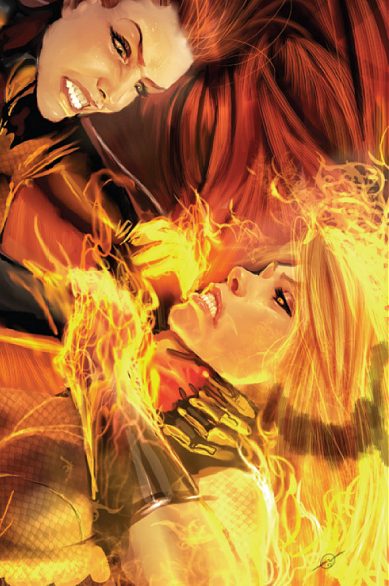

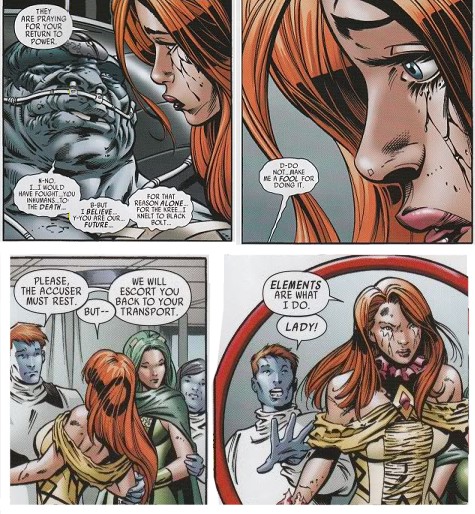



There are three main facts about Crystal's hair stripe:
It looks nothing like any functional hair band:
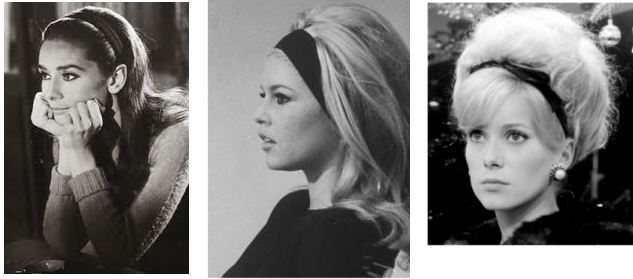
it would be impossible to make a hair band like Crystal's stripe,
as it is too high up to tuck behind anywhere. Look at the "Heroes
Reborn" Crystal hair band, it could only work if held in by pins at the
back, and the band would be lifted away from the hair .
It does not restrict the hair: in fact, it does not indent the hair on the slightest. That is, it does not do what a hair band is supposed to do.
It sometimes disappears, depending on the light.

The stripe also disappears when Crystal is sedated, and reappears when violence is mentioned:




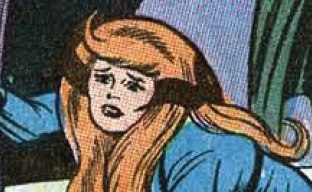
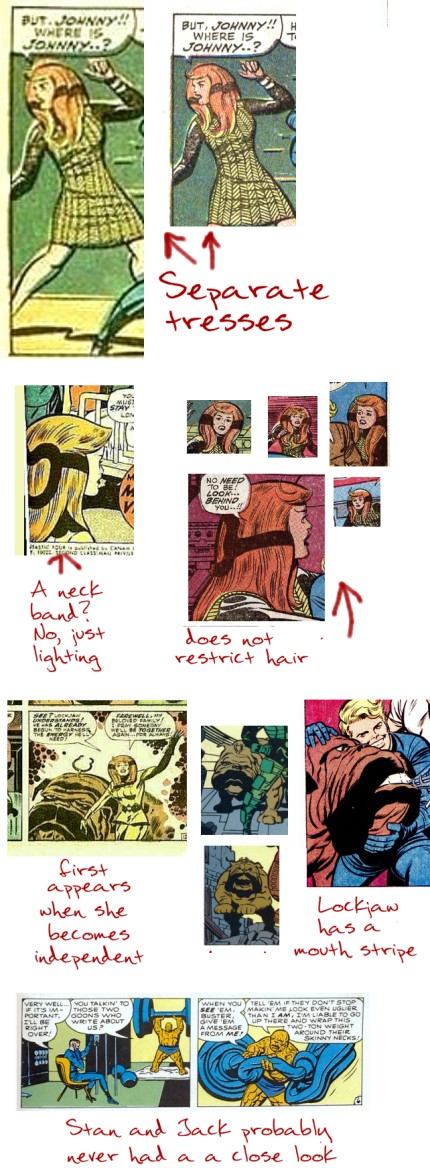



The hair dye theory fails for the same reason: why didn't Diablo just use one of his potions to remove it? If the world's greatest alchemist can control minds and build castles out of ruins I am sure he can remove some hair dye. And another thing, how long would it take to dye hair like that? Why would Crystal even bother? She can create earthquakes and firestorms with a wave of her hand: she does not need to dye her hair to be noticed.


The natural color theory seems to fail because we sometimes see Crystal without the hair pattern. But all of those times are when she is relaxed. For example, back home with the Inhumans in a subordinate role. Perhaps the pattern only appears when she is excited or using her power?
Human hair does not do this. is Inhuman hair so different? Yes, it is. Crystal's sister, Medusa, has prehensile hair, a result of the Terrigen mists. But the mists do not add on mechanical gadgets, they adjust the existing DNA. With humans that would make little difference to hair, because hair is dead, it is just a material produced by follicles. The fact that Inhuman hair can be triggered into life suggests that it is slightly different. Are there any examples of Inhumans cutting their hair? Sue Storm often cuts her hair, but Crystal's is always the same length as far as I can see.
What properties might living hair have? In animals, hair and skin coloring changes in order to send messages. I'm not talking about racial differences, but we blush when embarrassed, go red when angry, go pale when scared, go yellow with some illnesses, and so on. This is even more pronounced in animals. A cat's fur will rise to change to make itself look bigger when threatened. A chimpanzee's rear end changes color in the mating season. A young bird will change color to show it has become an adult. A chameleon will change color to camouflage, etc. Skin and fur sends messages with its coloring.
What is the mechanism for that change? Our skin changes color due to temperature, perhaps Crystal is the same? Humans regulate their body temperature by wearing extra clothing, avoiding cold places, perspiring, etc. But Crystal has a much better method: as an elemental she can easily create a micro-climate around herself. The inch of air immediately around her skin can can be exactly the temperature she wants. It is reasonable to assume that Crystal's surface temperature is slightly different when excited, and this could trigger the color change.
Limitations in early printing meant that most features had to be
either black or white - the coloring was added later, and reprints
often use different color schemes. Modern coloring is just as bad
for different reasons: it merely colors in the outline, and seldom
adds anything. Often it makes an image worse: a realistic outline
of clothing becomes unrealistic when airbrush coloring is added,
making clothing look like it's made of smooth plastic. Coloring
has a natural tendency to make rough things look smooth, so we can
easily dismiss any smoothness to the band. The point is, the art
is either black or white, and only the outline really matters.
Now imagine you have a cat who's coloring is subtle, with complex
patterns, and is sometimes more obvious than others, depending on
the lighting. How would you draw it, using only black ink on white
paper? If the pattern was faint you would not draw it at all. If
the pattern was clearer, you would create a simplified version - a
couple of stripes and circles perhaps. If Crystal has a complex
circular pattern on the back of her hair, it might sometimes be
drawn as a circle, sometimes as a figure eight, etc.
Crystal is an elemental. It makes sense for her to have an
elemental symbol on her. A symbol that is complex, and becomes
more pronounced when in action.
That's how I see it, anyway.
But after 1989? Well it's anyone's guess.

If we want to find 'the truth' from a comic, there are three layers of evidence to consider:
The intentions of the
writer and artist
are dictated by deadlines. No matter how much they may want to
spend months thinking about each page, comics in the 1960s didn't make
much money. They had to get the product out of the door. Hair bands were
popular, so Kirby drew Crystal with a hair band and probably didn't
give it another moment's thought. By this reasoning comics, and all
other forms of art produced to a deadline, are just disposable trash.
But if this is all we think about art, we may as well forget the topic.
The realism level is where
it gets interesting. This is the "fan boy" level of continuity and
treating these characters as people. Realism allows more people to
enjoy them, because everyone sees a story differently, but realism
lets us fill in gaps using our wider knowledge of the world. It is
still ultimately a business argument: realism only matters because
it extends a story's shelf life and market. I think on balance
that realism still favors the hair band model over the pure hair
model: i.e. after comparing all stories and applying Occam's
razor. But the question is not as clear cut as before. However, it
still leaves the real question unanswered: "why should we care?"
The idealism level is the
one that matters most to me. Yes, we have a whole pile of comics
(the business level). yes, we can construct a vast connected world
(the realism model). But why? What's it all for? Maybe we care on
the business level: they give five minutes of entertainment. Maybe
we care on the realism level: they give TEN minutes of
entertainment. But I think comics can be more than that. They can
inspire. They can let us see the world in a different way.
This is how I choose to read comics. Crystal is fundamentally
different, with different physiology (represented by two tone
hair). This fundamental different-ness makes me want to see things
from her point of view. So I read the early stories from her
viewpoint and find that tremendously rewarding.

Crystal's hair stripe is part of her hair, but the hair texture is different, causing the hair at that point to tend to stay together. The actual pattern and color are complex and depends on the lighting: it's colored as a solid black circle (or two circles) only for the inker's convenience.